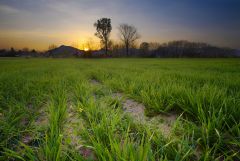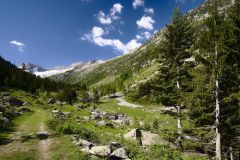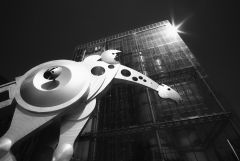
swallero
-
Posts
12 -
Joined
-
Last visited
Content Type
Forums
Gallery
Store
Posts posted by swallero
-
-
I initially had bought the Samyang 12mm. It was my second X lens (after the Fuji 35mm, that I love).
It's a very good ultra-wide lens. Very sharp at the center... not so much at the edges.
And... maybe too wide sometimes for my taste.
I used to have Canon EF 16-35 or 17-40mm on my 6d fullframe dslr.
But after switching to Fuji, I decided to go for the wonderful Fuji's primes.
Yesterday, after months spent with doubts (and sharing each and everyone of this thread's posts) I found a very good deal for an almost-new 16mm, and I bought it!!!
So now I have the 12mm (ultra-wide, perfect for tripod landscapes, seascapes, nightscapes) and the 16mm (a wonderful all-rounder, good for macro-like close-ups, not-so-wide landscapes, maybe some kind of nightscapes, and some special portraits, and street, and... did I say landscape already?)......
By the way, the samyang 12mm and fuji 16mm share the same filter thread: 67mm... Thus: same filters for my "landscape duo".
Stefano
-
I have the Samyang 12 (excellent value for money), but I really look forward to buy the 16mm (used and not at full price, if possible). Those two will be a great couple together!
-
-
Hi,
Yeap, for me is something there as well. I was looking for the closest to SHARPRNESS +2 in Fuji's in camera conversion as liked a lot the fine details produced (small radius), so for me the equivalent in my presets is 1.5 1.5 0.500, no blending. It works well only at lowest ISO's as increases grains afterwards.
In general I often use highpass filter: 5% (sharpness), 5% (contrast boost), overlay (blend mode) at 100%.
Unfortunately never managed to get something I liked with EQUALIZER


Cheers,
Vladimir
Hi Vladimir,
sharpness 1.5 1.5 0.500, no blending is a bit too much for my taste, but I appreciated very much your advice about highpass filter 5%-5%-overlay: it is fine and works great! thanks.
IMHO, equalizer is quite a useful tool... I often use it to enhance fine details, soften raw details, and to tweak chroma or luma noise reduction for selected detail ranges... Bye
-
Hi Stefano,
I've been using Darktable for about 3 years now and highlights was really what didn't work for me initially. Then I started using bilateral filter in the module it removed completely halos.
Then highlights slider doesn't work that great as in LightRoom, however I discovered another way to get it all back. If you look at the "base curve" it should be in "fujifilm like" mode by default which brings up highlights up too much for my test. You can drastically bring back any overexposed area (withing RAW range of course) playing with the curve. Double clicking on the graph will make the curve flat maximizing the dinamic range of your picture it can be a very good starting point. It's not that difficult as may look at first glance


Regards,
Vladimir
Thanks Vladimir,
I'll try some tweaking with the base curve, then.
I've also been trying to cope with parametric masks in order to recover highlight only in some parts of the image. That does avoid halos!
What setting are you using as far as SHARPNESS is concerned with fuji Raw files?
I'm currently using radium 0.8, quantity 1.5, threshold 0.250.... looks quite good at 200 to 800 ISO
-
The Samyang 12mm is my first wide angle lens for my Fuji XT1.
I'm loving it... but not completely.
1. the focus ring is quite stiff (as reported elsewhere), and the lens moves a bit on the camera body (maybe half a millimetre) while rotating the focus ring. That's quite an annoying issue, although it does not affect the final result.
2. Chromatic aberration is quite evident near the edges of the picture... I use linux darktable, which is not that clever at correcting chromatic aberration... not that happy about that. struggling a bit in post-production.
3. Loving the f/2 aperture!!! Useful for indoor shots, astrophoto (not tried that well enough, indeed), and some creative shots
4. Manual focus: quite easy to use... although the end of the focus ring does not correspond to infinity... That's actually a bit before the ring stop.
5. It's cheaper and wider than the XF 14mm... better suited for seascapes and countryside landscapes
6. I do think that the fujinon XF 16 f/1.4 would be the perfect wide companion for my Samyang 12mm.
Just waiting for the first used copies (or for some new fuji cashback coming to Italy in order to buy it new!!!)... :-)
Stefano
-
Hi guys.
I'm a Linux user, too. I have used Darktable for 2 years now as my main (and almost only) raw developer for Canon, and now for Fuji.
Yes, the learning curve is steep, but I love this software. It's rich of functions and complete, richer than Lightroom.
I still don't like some modules, such as highlights and shadows (not working well in my opinion, halos are so heavy!), and I think that noise removal is worse compared to competitors. Sometimes it hangs while using masks.
Indeed, I love the equalizer, curves, colors, defringe, and the use of parametric masks.
It's a pity we don't have chromatic aberration correction for Xtrans, yet (would be useful with my samyang 12mm f2)...
What kind of demosaicing method do you use? Markesteijn 3 for me, seems to be better than others.
I have not tried Lightroom (neither 5 nor 6) with FUJI RAFs, since my lightroom trial has expired.
How does it compare to Darktable, based on your experience?
Stefano





Having trouble deciding on the 10-24mm f/4 or the 16 mm 1.4 ... please help
in Fuji X Lenses
Posted
I have the 16mm, it's my favourite one.
I have the 12mm samyang, too, it was my second X lens, I don't want to get rid of it since it is useful when I need to go a bit wider and for nightscapes / milky way
never tried the 10.24mm, but I guess it might be the best lens for travel due to its versatility.